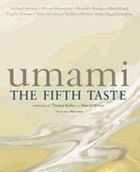
Most people are familiar with the four tastes--sweet, sour, bitter and salty--but some may not know there's a fifth: umami. Identified more than 100 years ago by Japanese scientist Kikunae Ikeda, umami is described here by 10 top chefs (all have Michelin-starred restaurants) as "an extremely pleasant fullness of taste," "earthy" (but not in a musty or mushroom-like way) and "subtle and refined." In Umami: The Fifth Taste, the scientific behavior of the flavor is analyzed by each chef, who then provides a variety of recipes that combine this "savory deliciousness" with other ingredients to make a synergistic explosion in the mouth.
Found in high concentrations in certain meats, vegetables, seafood and seaweed, the compound that creates umami is naturally occurring glutamate, an amino acid that has been synthesized into the artificial glutamate known as MSG. None of these recipes include MSG, as the chefs rely on a range of natural ingredients to create umami-rich dishes such as summer clams in a mushroom broth, duck dumpling soup and fire-roasted eggplant with squid caramel. Many of them call for esoteric ingredients such as paiche (an Amazonian freshwater fish), cancha (a Peruvian snack akin to Corn Nuts), tamarillo (a fruit) or birch syrup. Most recipes are for expert chefs, though the descriptions of some simple food combinations that create the same burst of umami are simple to follow and easy to reproduce, such as sardines in tomato sauce or hard cheese, sourdough rye bread and wheat beer. The glossary helps identify many unfamiliar ingredients, and the recipes on creating umami broth from seaweed are beneficial for adventurous home cooks. --Lee E. Cart, freelance writer and book reviewer

